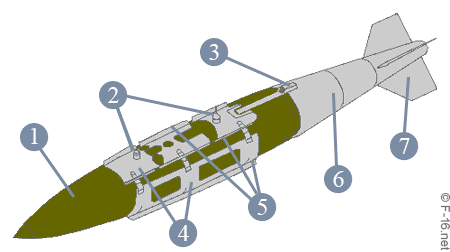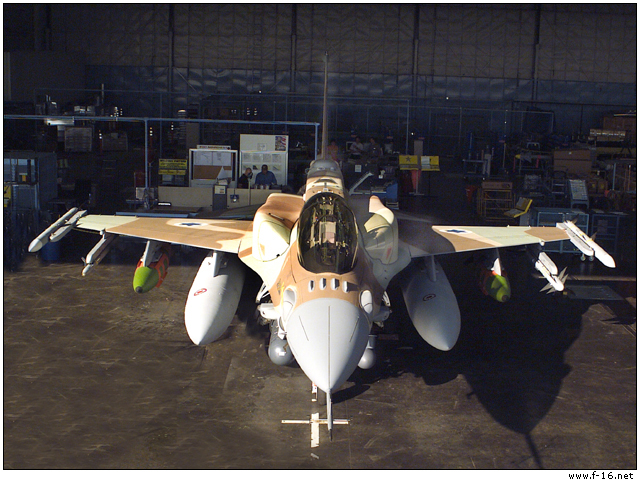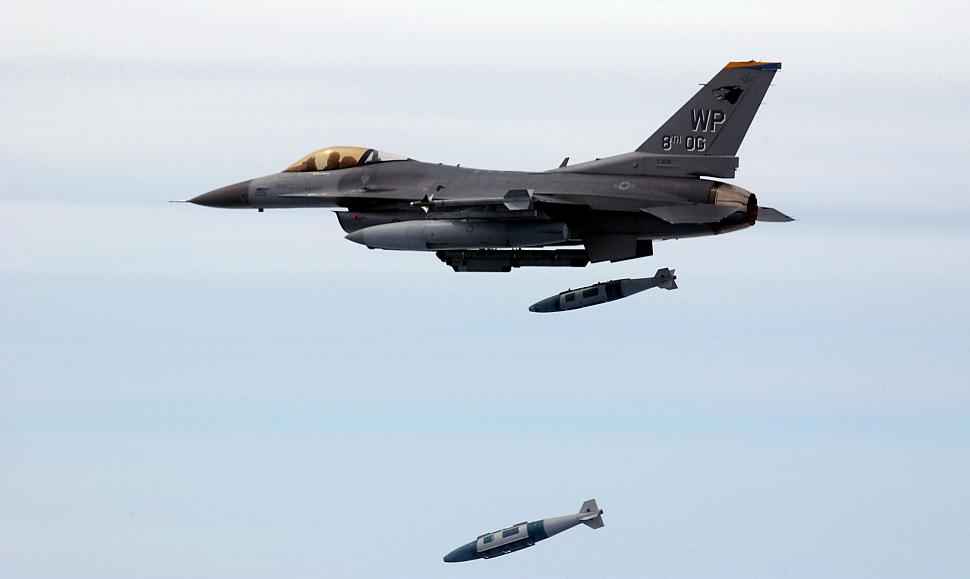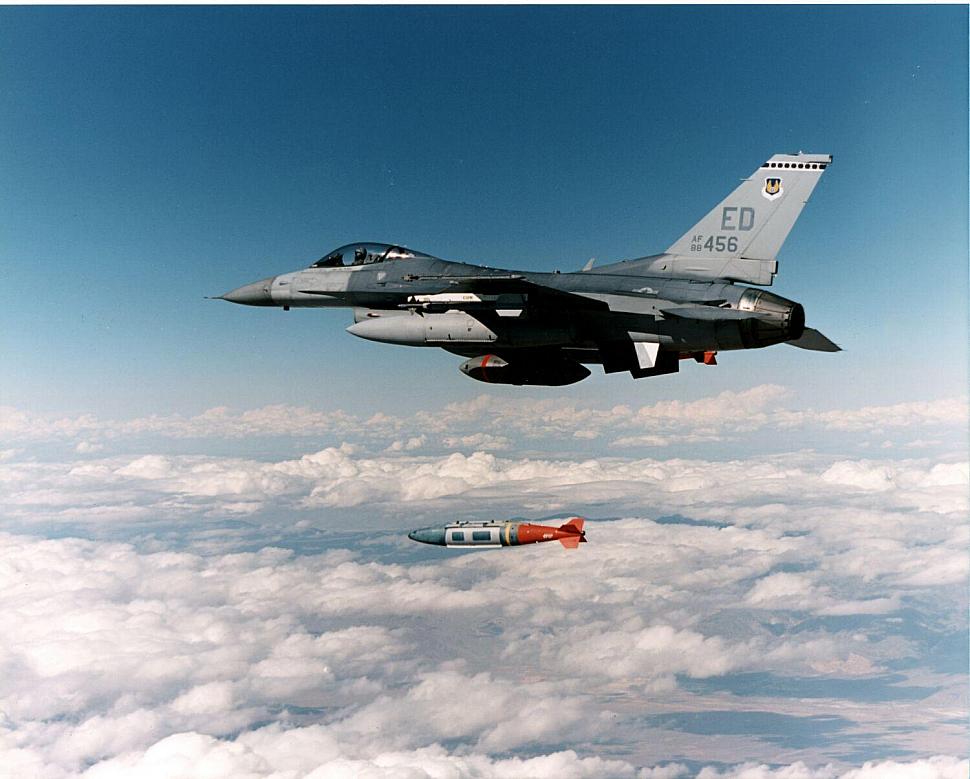Introduction
The Joint Direct Attack Munition (JDAM) is a guidance tail kit that converts existing unguided free-fall bombs into accurate, all-weather guided bombs. The JDAM kit consists of a new tail section containing an inertial navigational system and a global positioning system (GPS) guidance control unit. JDAM can be launched from approximately 15 miles from the target and each is independently targeted. JDAM was jointly developed by the U.S. Air Force and U.S. Navy, is built by Boeing, and can be fitted to the standard Mk.80 series of free-fall bombs. Each kit costs around $18,000 (FY 1999).
History
In the early 1990s, operation Desert Storm saw the first widespread deployment of smart bombs. The smart weapons used during Gulf War I were mainly Laser Guided Bombs (LGBs), i.e. standard Mk.80 series free-fall bombs fitted with a laser guidance kit. LGBs rely on the target being illuminated by a ground-based or air-borne laser designator. Since optical wavelengths are absorbed by water, adverse weather sush as fog, clouds, or rain tend to restrict the employment of laser-guided weapons. Although LGBs offer pinpoint accuracy in clear weather (day or night), they are of limited use in adverse weather.
At the same time, typical mission profiles flown in Desert Storm rendered unguided munitions even less precise. Aircraft would drop bombs from medium or even high altitude to avoid small-arms anti-aircraft fire, which degrades the accuracy of the unguided munitions.
These two factors established the need for a precision guided munition for all weather conditions. In the early 1990s, General McPeak, then USAF Chief of Staff, wrote down on a piece of paper something that he wanted industry to produce for him. He wanted an all weather precision guided bomb - something that didn't depend on good visibility like laser guided bombs. He even wrote down 'radar guided'. He didn't know tech things, he was a pilot by trade, all he knew is that he wanted a problem solved: to hit targets in any weather.
Research and development of the JDAM began in 1992. GPS was selected as guidance technology, mainly due to its low cost and off-the-shelf availability. A strike aircraft could acquire targets with advanced all-weather sensors, such as synthetic aperture radar (SAR), program GPS-guided weapons to hit individual targets at specific locations, drop the weapons simultaneously, and then leave immediately. The weapons would proceed on track to their individual targets without further intervention.
In October 1995, the Air Force awarded a contract for EMD and for the first 4,635 JDAM kits at an average unit cost of $18,000, less than half the original $40,000 estimate. The first JDAMs were delivered in 1997 with operational testing conducted in 1998 and 1999. More than 450 JDAMs were dropped during testing, recording an unprecedented 95 percent system reliability while achieving a 9.6-meter accuracy rate. JDAM performance has been demonstrated in adverse weather conditions, including drops through clouds, rain and snow.The US Air Force, Navy, and Marine Corps originally planned to acquire a total of over 87,000 JDAM kits from Boeing, with total program cost of over $2 billion USD. The US military has been so enthusiastic about the weapon that their total buy may reach about 250,000, and there has been talk of eliminating unguided bombs entirely from the inventory. JDAM has also been sold to foreign customers, with Israel and Italy placing the first export orders.
Construction
The JDAM kit is a rather simple modification, which explains its low cost. It consists of a tail section and a jacket which is wrapped around the body of the free-fall bomb. Different tails and jackets are available for different bombs.

- Key to drawing:
- Warhead
- Suspension lugs
- 1760 interface
- Jacket
- Strakes
- Guidance section
- Fins
The tail has moveable fins, and contains a thermal battery and a guidance system. The latter consists of a GPS (Global Positioning System) receiver and an Inertial Navigation System (INS). The guidance system is connected to the parent aircraft by an umbilical connection, though a wireless infrared link is in the works. Different fuses are available: the BLU-109 penetrator warhead will penetrate the surface before detonating, but the fuse can also be set for airburst or contact.
The jacket is wrapped around the body of the bomb. Its purpose is to enhance maneuverability and range through the mid-body strakes that act as aerodynamic surfaces.
Versions
JDAM variants used by F-16's
GBU-31
Two versions are available: the GBU-31(V)1/B is based on the 946 kg (2085 lb) Mk.84 warhead, and the GBU-31(V)3/B is based on the 981 kg (2162 lb) BLU-109 forged steel penetrator warhead.
GBU-38
JDAM kit with a Mk.82/BLU-111/B. 253 kg (558 lb).
F-16 Installation

F-16 Loadout
The USAF F-16 fleet only uses the GBU-31 and GBU-38. Stations 3 and 7 have been wired to carry a single JDAM. Other stations are not fully equiped for the JDAM. With the addition of the BRU-57/A Multiple Carriage, "Smart" Bomb Rack, two GBU-38's can be carried on stations 3 and 7.
 |
 |
F-16 Loading
Munition specialists assemble the bombs on base. They take a conventional dumb bomb, attach the JDAM kit to it and make sure it is serviceable, then load it on the aircraft.
Aiming & Firing
Coordinates for preplanned, fixed targets are fed into the JDAM by the aircrew. These coordinates are for example determined from high-resolution aerial images. If the targets are not pre-planned (e.g. most targets in Afghanistan and Iraq were not), the aircraft carrying the JDAM shows up in the target area and is assigned a target by a JSTARs aircraft, Forward Air Controller, or another source. If the launch aircraft has radar assist capability (e.g. B-1, B-2, F-18E/F, and the latest F-16s), radar data can be used to refine the target coordinates.
The JDAM automatically begins its initialization process during captive carry when power is applied by the aircraft. The weapon performs Built-in Testing, and aligns its INS with the host aircraft's system. Targeting data is automatically down loaded to the weapon from the host aircraft. When the host aircraft reaches the release point within the Launch Acceptable Region (LAR), the pilot releases the weapon.

JDAMs can be released from over 10 miles away and from high altitude. This allows the launch aircraft to avoid small Surface-to-Air Missiles (SAMs) or Anti-Aircraft Artillery (AAA or triple A), thus increasing survivability.
A particular concern for JDAM is GPS jamming. However, this is less a of problem than originally anticipated. First of all, the GPS signal now resides on a secure topology - the GPS kit knows if it is getting a certified GPS signal or not. The U.S. Department of Defense has received additional funding to make this process even more secure and to improve the ability of the kit to acquire GPS signals under various jamming scenarios. Secondly, if the JDAM kit does not acquire a GPS signal on the way down, the Inertial Navigation System in the kit will get the weapon near the target with variable accuracy (depending on conditions) and will not be influenced if instructions from the GPS fall outside of a certain range. All this was proven in combat when in Iraq, an enemy GPS jammer was taken out with a JDAM.
Operational Use
JDAM and the B-2 made their combat debuts during Operation Allied Force. The B-2s, flying 30-hour, nonstop, roundtrip flights from Whiteman Air Force Base, Mo., delivered more than 600 JDAMs during Allied Force.
The very first combat drops of the GBU-31 JDAM by an F-16 unit were made in Afghanistan on November 29, 2001, by the 389th EFS during their deployment for Operation Enduring Freedom to Al Udeid AB, Qatar. Pilots of this historic mission were Col. William F. Andrews (366th AEG commander) and Capt. Paul Kirmis (389th FS pilot).
The first combat use of the GBU-38 JDAM was made in late September 2004 by the 187th FW during their deployment for Operation Iraqi Freedom to Al Udeid AB, Qatar, as part of an ANG "Rainbow Team". Two F-16s performed a simultaneous GBU-38 release on the same target in central Iraq. The bombs hit a two-story building with minimal collateral damage. This was "a successful precision strike on a confirmed Abu Musab al-Zarqawi terrorist meeting," Coalition Press Information Center officials said. Flight leader of the mission was Lt. Col. Mitch, his wingman was Maj. Brian.
Specifications
Primary Function: Offensive interdiction precision-guided weaponContractor: LM Aero & Boeing
Guidance System: GPS assisted Inertial Navigation System
Unit Cost: $18,000 (FY 1999)
GBU-31(V)1/B
3.879 Length (m)
46 Diameter (cm)
946 Launch Weight (kg)
8 - 24 Range (km)
(Mk-84) Bomb
GBU-31(V)3/B
3.774 Length (m)
37 Diameter (cm)
981 Launch Weight (kg)
8 - 24 Range (km)
(BLU-109 Forged Steel Penetrator) Bomb
GBU-38/B
2.353 Length (m)
27.3 Diameter (cm)
253 Launch Weight (kg)
8 - 24 Range (km)
(Mk-82 or BLU-111/B) Bomb
Note: Nomenclature designations above are over-simplified. There are more sub-variants depending on various upgraded appliances on the JDAM kit. The designations shown here will do for the purpose given. Also GBU-32, the 468 kg (1031 lb) Mk83 or BLU-110 variants have been tested on the F-16 but are not commonly seen in field use at this time. Currently, the GBU-32 series is more of a U.S. Navy and USAF F-22 specific weapon.
Similar Weapons
Advanced Unitary Penetrator
The Advanced Unitary Penetrator (AUP) is a 2,000 lb. penetrator warhead intended as a successor to the BLU-109 warhead. The AUP is designed to provide increased penetration capability while maintaining the same overall weight, dimensions, and physical interfaces of the BLU-109 warhead, thus ensuring compatibility with the GBU-31 guidance kit. The AUP uses the Hard Target Smart Fuze (HTSF), an electronic fuze which allows control of the detonation point by layer counting, distance or time. The HTSF contains an accelerometer which senses G loads caused by sudden deceleration of the bomb as it penetrates through to the target. This allows the fuze to distinguish between earth, concrete, rock and air.
Small Diameter Bomb (SDB)
Unlike JDAM, the Small Diameter Bomb is not a kit that is attached to a dumb bomb, but a single unit 250lb class weapon which weights 285lbs. It consists of a small 50lb warhead and GPS/INS guidance section and fold out wing kit which gives it some stand-off range qualities. The SDB requires a BRU-61/A smart pneumatic carriage which holds four SDB weapons. The BRU-61/A with four SDB's were designed to fit in the weapons bay of an F/A-22. SDB is currently operational with USAF F-15E aircraft. It has a penetrator shape which offers the similar penetration capability as the heavy forged steel penetrator BLU-109. Airburst is also an attack option. The pinpoint accuracy of this weapon combined with its penetration capability more than compensate for the smaller warhead. Initial tests with the F-16 have already been performed. Currently unit cost of the SDB is high compared to a JDAM kit.
Enhanced Paveway/Paveway IV
Designed with U.K. inventory of free-fall bombs in mind, which are not compatible with the JDAM kit. Paveway IV is a combined laser guided/GPS kit. It can be used as a LGB, or if the target is covered by weather, as a GPS-guided munition. Unit cost is higher than an LGB kit. Enhanced Paveway was used by the U.K. and USAF F-117s in Iraq. Enhanced Paveway is also used by the U.S. Navy. Paveway IV is a further development of the Enhanced Paveway, adding a second-generation anti-jam, anti-spoof GPS with a low-cost inertial measurement unit to the laser seeker.
Longshot
Longshot by Lockheed/Martin, is a low-cost, GPS/INS self-contained wing adaptor kit that provides range extension and autonomous guidance capability to a wide range of existing air-to-surface munitions. Wireless operation. LongShot does not require MIL-STD-1760 interface Using the UHF radio on the jet to punch in the target to the bomb using a keypad like what is on the Upfront Display.
French AASM GPS kit
A GPS guidance kit for free-fall bombs, developed by Sagem. Currently available for 500lb bombs, but kits for heavier bombs are under development. The kit is compatible with an optional strap-on IR seeker. This kit will likely be deployed with the new Rafale fighters. A common configuration for a Rafale and this weapon would be 3 on each wing with the new triple ejector rack, which can also hold the GBU-12 (500lb LGB).
SPICE
Israeli GPS kit with an IR seeker. The kit completely encloses the bomb. Unit cost unknown.
KAB-500E
GPS/Glonass kit for Russian 500kg bomb. Total funding and deployment into the Russian Air Force; unknown.
LS-6
LS-6 is a solution for the Chinese PLAAF which uses 462 kg. class dumb iron mated to a GPS assisted precision kit. This also includes a fold out wing for extending glide range.
Special thanks
- ELP, (JJ for F-16 combat use) and munitions experts on the f-16.net forum
Sources
- Boeing JDAM webpage: http://www.boeing.com/defense-space/missiles/jdam/flash.html
- USAF Fact Sheet "Joint Direct Attack Munitions GBU-31/32": http://www.aog-usafa.org/Fact_Sheets/Joint_Direct_Attack_Munitions_GBU_31_32.htm
- GlobalSecurity.org on JDAM: http://www.globalsecurity.org/military/systems/munitions/jdam.htm
- Boeing Anti-Jam Press release: http://www.boeing.com/news/releases/1998/news_release_980423n.htm
- Boeing completes 500lb JDAM testing with F-16. Oct 2002: http://www.boeing.com/news/releases/2002/q4/nr_021031m.html
- Boeing demonstrates Diamondback: http://www.afrlhorizons.com/Briefs/Jun02/MN0206.html
- Original thoughts in the UK Parliament on the direction their all weather bomb kit should take: http://www.parliament.the-stationery-office.co.uk/pa/cm200001/cmselect/cmdfence/463/463ap04.htm
- PDF file on Russian GPS/Glonass kit: http://www.milparade.com/2002/54/042.pdf
- Israeli SPICE kit, captive carry on a Saab Gripen: http://www.gripen.com/images/nato/hi_res/1a_hi.jpg
Salute!
Super article, and many thanks to ELP and the site 'janitors'.
I was fortunate to work on the JDAM product improvement program way back..... The initial operational concept demonstration was still in progress and the thing was exceeding its expectations.
GPS algorithms by private industry, NOT U.S. goverment were a very significant factor in achieving the accuracy. Commercial GPS systems for boating and surveying were getting better and better all the time. Using differential systems, whereby a fixed ground station could broadcast ephimeris corrections and also defeat the 'selective availability' U.S. employed to thwart enemy use, it was possible to achieve 2-3 meter navigation accuracy. Our company used the 'surveying' software and achieved 2-3 centimeter accuracy, but not in real time.
The problem was vertical accuracy, e.g. hitting the side of a mountain or building. Initial JDAM had super horizontal accuracy, as the trajectory was almost straight down.
Our company worked on mission planning concepts plus the electrical interface and were thoroughly briefed by all major companies that were developing terminal guidance systems - IIR, millimeter wave radar, LIDAR, and electro-optical. So we derived data transfer requirements and suggested various tools to allow the crews and targeting folks to pass on the data to the JDAM.
By the end of testing the JDAM was so good that the product improvement effort was slowed and emphasis was placed upon smaller JDAM bombs that could be carried in the F-22 bays.
Apparently, costs have dropped, and the 'precision' JDAM (CEP less than 3 meters) is getting attention.
From personal experience almost 8 years ago, I can tell you that sensor technology was awesome then, and the result of the latest efforts will be dramatic, to say the least. For example, the MMW radar will likey be able to acquire targets(including moving tgts) based upon specific signatures, then lock-on and provide steering data to JDAM's basic system. I saw MMW prototypes back then that could sort between tanks, trucks and SAM sites. Imagine nowadays. The LIDAR systems were very good for structures and the IR systems super for hitting tgts with vertical aspects. The problem will be the aerodynamic surfaces required to make the last second corrections.
As far as GPS jamming is concerned, imagine the bad guys not knowing when to turn the thing on. If they leave it on at the wrong time, they will attract a HARM or even a 'mini-harm' from a Predator drone. Heh heh. Besides, the satellites are above the JDAM, so jamming sugnals must be very strong to have an effect. Finally, the strapdown inertials being used are getting better every day. If the JDAM loses good GPS data at 'x' range, the CEP will not change all that much.
Great discussion.
respectfully,
BTW.... the comments from above come from a guy that had to do it "the hard way" for years with dumb iron and get shot at while doing it, every now and then. ;)
Corrections to this article:
There really is no GBU-29/30 in service. Probably a more accurate list would be...
GBU-31(V)1/B (USAF) Mk 84
GBU-31(V)2/B (USN) Mk 84
GBU-31(V)3/B (USAF) BLU-109 penetrator ( not to be confused with "bunker busters" )
GBU-31(V)4/B (USN) BLU-109 penetrator ( not to be confused with "bunker busters" )
GBU-32(V)1/B (USAF) Mk 83
GBU-32(V)2/B (USN) Mk 83
GBU-35(V)1/B (USN) BLU-110
GBU-38 - Mk-82 *
( note currently USAF doesn't use the Mk83 or BLU 110 1000lb dumb iron, but this could change as 2 GBU-35s could be crammed into the F-22 for use. Making its interal stealth bombing ability being 2x 1000lb JDAM or several SDB's. )
You will see other GBUs like GBU-34 mentioned in some public sources. This project was a government competition, just like the Northrop-McDonnell Douglas YF-23 lost to the Lockheed YF-22, so did the Lockheed GBU-34 lose to the Boeing JDAM solutions.
The B-2 used Northrop made "GAM" kits in Allied Force 1999 not Boeing JDAM.
Disclaimer. When discussing munition names, always go with what a REAL bomb loader says. They are the ones that know all the names of kits, warheads, weapons racks etc., build them and load them. So more times than not, they are correct.
Just a few notes on the 'similar weapons' to round off an excellant article.
Enhanced Paveway 2 (UK) - Paveway II (UK) upgraded with Enhanced Paveway dual mode GPS/Laser seeker and interface kit. Warhead is a UK 1000lb (Mk 20), aerofoil group is as per Paveway II (UK).
Enhanced Paveway 3 (UK) - Paveway III (UK) upgraded with dual mode GPS/Laser seeker and interface. Warhead is a variant of BLU-109. Similar to an EGBU-24 with some UK features.
Paveway IV - Outwardly similar to an EGBU-12 but distinguished by a revised UK specific dual mode GPS/Laser seeker with HOB sensors, hardback incorporating UK specific interfaces, a revised warhead similar in size and shape to a Mk-82.
Worth noting that both Raytheon and Lockheed provide 'EGBU-12' kits that upgrade a GBU-12 in a similar manner to an Enhanced Paveway 2 (UK).
A few errors in my comment post above.
-B2 used JDAM in Operation Allied Force, not the early NG "GAMS".
-BLU-110 is not a penetrator (forged steel pointy tip in the style of BLU-109 )
-GBU-32 is F-22 fodder AFAIK
New update coming soon for this page. Also SS I will use your Paveway info above. Any gross errors on this are my fault so if there are any public consumption corrections you need to see PM me on the forum.
Elp,
With the Danes having completed initial flights it will be worth adding the GBU-49 (I believe this has replaced EGBU-12 as the formal designation) Enhanced Paveway into the article.
For clarification, it was actually two GBU-27A/B (enhanced Paveways) that took out the GPS jammers in Iraq, not JDAMs. Know the guys, seen the videos.
The BLU-116 AUP, which is only being used by the US Navy at this point, has been mated exclusively to the GBU-24E/B Enhanced Paveway III, and is not being used with the JDAM kit at this time.
GBU-48 is the nomenclature for the Raytheon enhanced GBU-16. GBU-50 is the nomenclature for the Raytheon enhanced GBU-10.
Please use this form to add any list any error or omissions you find in the above text.
Note: your comments will be displayed immediately on this page. If you wish to send a private comment to the webmasters, please use the Contact Us link.



